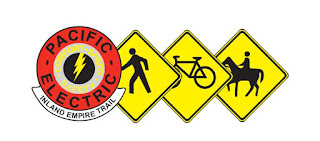 |
| Friends of the Pacific Electric Trail |
In recognition of a “first” we want to acknowledge Neilson Powless as the 1st First Nation entry into the Tour de France. Since its’ inception 117 years ago the tour has been dominated by a few dozen countries and cultures, but as Americans we take great pride in this Native son of Wisconsin’s Oneida tribe. This race for Neilson, as well as all participants, a personal effort and achievement. But on his narrow shoulders he carries his tribal culture, his states representation, and all our hopes for success in his future efforts. Thank you, Neilson!
LE PECQ, France (AP) —
A late draft to the Tour de France, Neilson Powless didn’t have time to
scramble together a turtle necklace, the spirit animal of his Native American
tribe, or paint one of their wampum bead belts on the frame of the bike that
he’s ridden for three punishing weeks, over 3,300 kilometers (2,000 miles) of
roads. Unable to carry the Oneida
Tribe’s symbols with him, the Tour rookie has become a powerful symbol himself
as the first tribally recognized Native North American to have raced in the
117-year-old event.
Not only has Powless survived
cycling’s greatest and most grueling race, he distinguished himself in a crop
of exciting young talents who helped set this Tour alight. Crossing the finish
in Paris on Sunday will, he hopes, resonate on reservations back in the United
States. His main hope is that he can be
a positive role model for young indigenous kids who have a lot going against
them. Powless, who turned 24 during the
race, told The Associated Press, “I think finishing the Tour de France is a
testament to years of hard work and dedication to a lifelong dream. Hopefully,
I can help drive kids to setting their mind to a goal and going after it.”
It must make it a lot easier when you can see
somebody else who is doing it, or has done it, he adds. Even during
a pandemic, he did not falter or give up on his dreams. Word of Powless’
feats in France has already filtered back to the Oneida Nation in Wisconsin. The tribal chairman, Tehassi Hill, shared that the first
ever Native American cyclist is blazing a trail of journey, hope and
inspiration. Whenever one of our
own, from the Oneida community, are in the spotlight, it definitely does not go
unnoticed. Neilson’s journey and accomplishments, I’m sure are spoken of at
many gatherings here in Oneida,” Hill told JOHN LEICESTER at the AP.
Tour de France for many is a tradition that
has stood the test of time. Seasoned
cyclists gather from around the world to compete in the 117-year-old race. I was truly inspired to discover this story
of determination from a native-born son and the path that he is charting for
future generations. Powless has the same
kind of inner strength that reminds me of my Grandfather, who never missed an
opportunity to share stories of courage, determination, and hard work with me
when I was a little boy. My
grandfather’s stories were always exciting and full of adventure and their
meaning always stuck with me. Powless
reminds me of those hero’s my grandfather spoke of so many years ago.
The Tour confirms he
is its first Native North American competitor. The cyclist has not made a fuss
of his heritage. Powless learned he is one-quarter Oneida from from his father just days
before he took the Tour start on Aug. 29, 2020.
Powless proudly points out that he has a tribal ID recognizing him as
one of the 16,500 Oneida Nation members. The tribe has helped him financially with
schooling and has family on the reservation. “It’s not that I just had a blood
test one day and decided ‘Oh, I guess I’m Native American.” It is something I have, like, sort of grown up
with and it has been part of my whole life and the tribe recognizes that as
well.
Told just days before the Tour
that he was on the team, Powless says he did not have time to discreetly
decorate his bike or source a replacement for the turtle necklace he broke last
year. Still, based on his performances, he
will surely be back and able to fix that at future Tours. “Normally I would
have a painting of the Oneida bead belt, the wampum belt, somewhere on my bike,
my garment, my shoe,” he said. “Just something small, most people wouldn’t even
really see it. It’s just something that I have always tried to keep close to
me.”
Cycling is an important part of
my life because it fulfills both exercise and fun and never disappoints, why do
you cycle, please comment below.
 |
| Friends of the Pacific Trail |
Like us on Facebook








